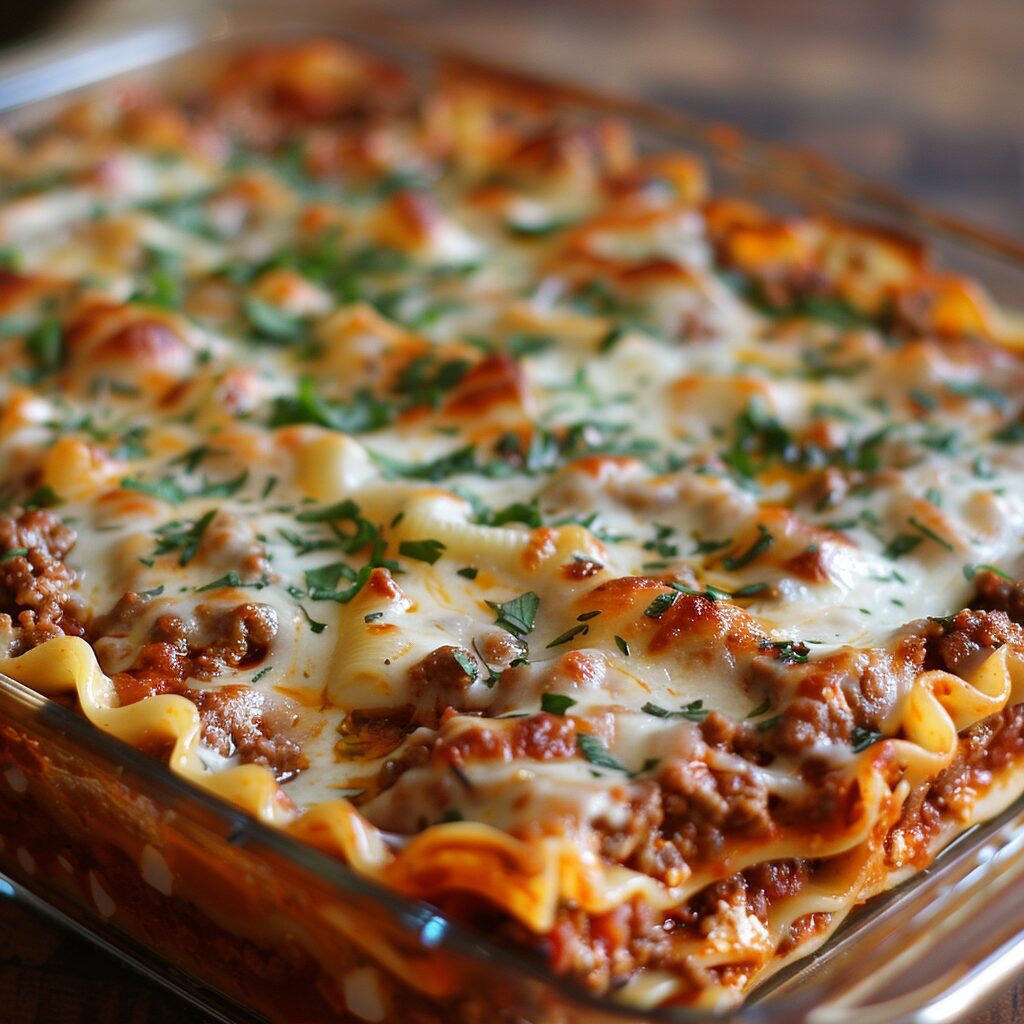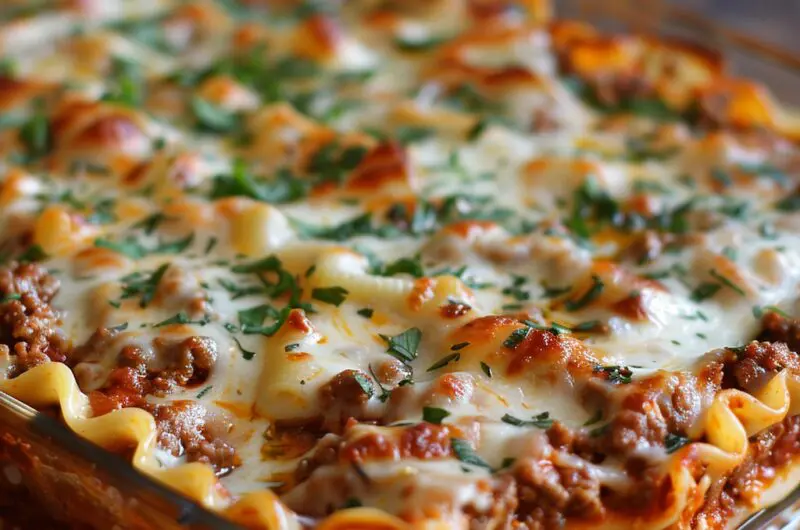Lasagna, the beloved Italian comfort food, has been gracing dinner tables for generations. But despite its popularity, many home cooks unknowingly make crucial mistakes that prevent their lasagna from reaching its full potential. From soggy noodles to watery sauce, these missteps can turn what should be a culinary masterpiece into a disappointing dish. But fear not! We’re here to unveil the secrets of perfect lasagna-making and help you avoid the pitfalls that have been holding you back. Get ready to transform your lasagna game and impress your family and friends with layers of pure deliciousness.
The Foundation: Noodles and Sauce
Let’s start with the backbone of any great lasagna: the noodles and sauce. One of the most common mistakes is overcooking the noodles. You might think softer is better, but this often leads to a mushy final product. Instead, cook your noodles until they’re just shy of al dente. They’ll continue to cook in the oven, absorbing flavors from the sauce and maintaining that perfect texture.
Speaking of sauce, many home cooks underestimate the importance of a thick, flavorful meat sauce. Watery sauce is the enemy of good lasagna. Take the time to simmer your sauce until it reaches a thick, almost paste-like consistency. This concentrated flavor will permeate every layer, ensuring a rich taste in every bite. Don’t forget to brown your meat before adding it to the sauce – this simple step adds depth and complexity to the overall flavor profile.
Another crucial aspect often overlooked is seasoning. Your pasta water should be as salty as the sea – this is your chance to infuse flavor into the noodles themselves. And don’t be shy with herbs and spices in your sauce. A blend of basil, oregano, and a touch of fennel can elevate your lasagna from good to extraordinary.
Tip: For perfectly cooked noodles, invest in a large pasta pot. This allows your noodles to move freely, preventing them from sticking together during cooking.
When it comes to layering, many people make the mistake of being too generous with the sauce. While it might seem counterintuitive, using too much sauce can lead to a soupy mess. Aim for about 1 1/2 cups of sauce per layer, ensuring even distribution without drowning the other components.
Lastly, don’t forget the importance of letting your sauce simmer. A good meat sauce benefits from at least 1.5 hours of simmering time. This allows the flavors to meld and develop, resulting in a more complex and satisfying taste. Patience is key when it comes to creating the perfect lasagna foundation.
Cheese Please: Mastering the Dairy Components
The cheese layer is where many lasagna dreams go to die. One common mistake is using the wrong types of cheese. While it might be tempting to throw in whatever you have in the fridge, stick to cheeses that melt well and complement each other. The classic combination of ricotta, mozzarella, and Parmesan is popular for a reason – it provides the perfect balance of creaminess, stretch, and sharp flavor.
Another frequent error is not draining the ricotta properly. Excess moisture in your cheese mixture can lead to a watery lasagna. To combat this, try mixing your ricotta with an egg and some grated Parmesan. This not only helps bind the mixture but also enhances the flavor and texture of your cheese layer.
Many home cooks overlook the potential of adding a béchamel sauce to their lasagna. This creamy white sauce can take your lasagna to the next level, adding a velvety texture and rich flavor that perfectly complements the tangy tomato sauce and savory meat.
Tip: For the perfect cheese pull, consider using a cheese grater designed for mozzarella. This will ensure your cheese melts evenly throughout the lasagna.
When it comes to layering your cheese, be sure to cover the entire surface of each layer. Leaving corners exposed can result in dry patches in your finished lasagna. And don’t be afraid to get creative with your cheese choices – while the classic combination is fantastic, experimenting with cheeses like fontina or Pecorino Romano can add interesting new dimensions to your dish.
The Art of Assembly and Baking
Now that we’ve covered the key components, let’s talk about putting it all together. One of the biggest mistakes people make is not using a deep enough baking dish. A shallow dish can lead to overflow in the oven and doesn’t allow for enough layers to achieve that perfect lasagna structure. Opt for a dish that’s at least 3 inches deep to accommodate all your delicious layers.
When layering your lasagna, pay attention to the direction of your noodles. Laying them in the same direction for each layer will make it easier to cut and serve clean, beautiful slices. And don’t forget to start and end with a layer of sauce – this prevents the noodles from drying out and sticking to the pan.
Baking is where many lasagnas meet their downfall. Overbaking can lead to dry, tough noodles and scorched cheese. To prevent this, cover your lasagna with foil for the majority of the cooking time. This traps moisture and ensures even cooking. Remove the foil for the last 15-20 minutes to allow the cheese to brown and bubble to perfection.
Tip: To prevent cheese from sticking to your foil, place a layer of parchment paper between the lasagna and the foil. You can also use non-stick foil for easy removal.
Perhaps the most overlooked step in lasagna-making is the resting period. It’s crucial to let your lasagna rest for at least 15-30 minutes after removing it from the oven. This allows the layers to set and makes it much easier to cut and serve without everything falling apart. Plus, it gives the flavors a chance to meld and intensify.
Finally, don’t be afraid to make your lasagna ahead of time. In fact, many chefs swear that lasagna tastes better the next day. You can assemble your lasagna and refrigerate it for a day or two before baking, or even freeze it for up to three months. Just be sure to thaw it completely in the refrigerator before baking.
Making the perfect lasagna is an art form that requires attention to detail and a bit of patience. By avoiding these common mistakes and implementing these expert tips, you’ll be well on your way to creating a lasagna that’s worthy of an Italian nonna’s approval. Remember, practice makes perfect, so don’t be discouraged if your first attempt isn’t flawless. Keep refining your technique, and soon you’ll be known as the lasagna master among your friends and family. Buon appetito!
Perfect Homemade Lasagna
Course: Main CourseCuisine: Italian4
servings30
minutes40
minutes300
kcalMaster the art of lasagna-making with this foolproof recipe that ensures layers of pure deliciousness in every bite.
Ingredients
1 pound sweet Italian sausage
1 pound lean ground beef
1 large onion, finely chopped
5 cloves garlic, minced
2 (28 ounce) cans crushed tomatoes
2 (6 ounce) cans tomato paste
1/2 cup water
2 tablespoons sugar
1/2 cup chopped fresh basil
1 teaspoon Italian seasoning
1 1/2 teaspoons salt
1/4 teaspoon ground black pepper
1/4 cup chopped fresh parsley
12 lasagna noodles
16 ounces ricotta cheese
1 egg
1/2 teaspoon salt
3/4 pound mozzarella cheese, sliced
3/4 cup grated Parmesan cheese
Directions
- In a large pot, cook sausage, ground beef, onion, and garlic over medium heat until well browned. Stir in crushed tomatoes, tomato paste, water, and sugar. Season with basil, Italian seasoning, 1 1/2 teaspoons salt, pepper, and 2 tablespoons parsley. Simmer, covered, for about 1 1/2 hours, stirring occasionally. This long simmering time allows the flavors to meld and develop, resulting in a rich and complex sauce.
- Bring a large pot of lightly salted water to a boil. Cook lasagna noodles in boiling water for 8 to 10 minutes, or until they are al dente. Drain noodles, and rinse with cold water to stop the cooking process. This prevents them from becoming too soft and falling apart during assembly.
- In a mixing bowl, combine ricotta cheese with egg, remaining parsley, and 1/2 teaspoon salt. This mixture will create a creamy and flavorful cheese layer in your lasagna. The egg helps to bind the ricotta, preventing it from becoming too watery during baking.
- Preheat oven to 375 degrees F (190 degrees C). To assemble, spread 1 1/2 cups of meat sauce in the bottom of a 9×13 inch baking dish. Arrange 6 noodles lengthwise over meat sauce. Spread with one half of the ricotta cheese mixture. Top with a third of mozzarella cheese slices. Spoon 1 1/2 cups meat sauce over mozzarella, and sprinkle with 1/4 cup Parmesan cheese.
- Repeat layers, and top with remaining mozzarella and Parmesan cheese. Ensure that you cover the entire surface with sauce and cheese to prevent any dry spots. This layering technique creates the perfect balance of flavors and textures in every bite.
- Cover the baking dish with foil, making sure it doesn’t touch the top layer of cheese. This helps to trap moisture and prevent the cheese from burning. Bake in preheated oven for 25 minutes.
- Remove foil, and bake an additional 25 minutes. This allows the cheese to brown and bubble, creating that perfect golden-brown crust on top. Look for the edges to be crispy and the center to be hot and bubbly.
- After removing from the oven, let the lasagna rest for at least 15 minutes before serving. This resting period is crucial as it allows the layers to set and makes it much easier to cut and serve without everything falling apart. It also allows the flavors to further meld together, resulting in a more delicious final product.
Notes
- For best results, make the sauce a day ahead and refrigerate overnight. This allows the flavors to develop even further.
- If you prefer a vegetarian version, substitute the meat with a mixture of sautéed vegetables like zucchini, eggplant, and mushrooms.
- For a richer flavor, try using a mixture of different cheeses like fontina or Pecorino Romano along with the mozzarella and Parmesan.
Frequently Asked Questions About Making Lasagna
Q: Can I use no-boil lasagna noodles?
A: Yes, you can use no-boil lasagna noodles. However, traditional noodles that are boiled until just shy of al dente often provide a better texture. If using no-boil noodles, ensure your sauce is slightly thinner as these noodles will absorb more liquid during baking.
Q: How can I prevent my lasagna from being watery?
A: To prevent watery lasagna, make sure your meat sauce is thick and not too watery. Drain excess fat from the meat after browning. Also, if using ricotta, mix it with an egg to help bind it. Lastly, let your lasagna rest for at least 15 minutes after baking to allow the layers to set.
Q: Can I make lasagna ahead of time?
A: Absolutely! Lasagna is a great make-ahead dish. You can assemble it a day in advance and refrigerate it unbaked. When ready to serve, let it sit at room temperature for about 30 minutes before baking. You can also freeze unbaked lasagna for up to three months. Thaw in the refrigerator before baking.
Q: What’s the best way to reheat leftover lasagna?
A: The best way to reheat lasagna is in the oven. Preheat your oven to 375°F (190°C), cover the lasagna with foil to prevent it from drying out, and heat for about 25-30 minutes or until it’s hot throughout. You can remove the foil for the last 5 minutes if you want a crispy top.


